First of all, to explain: Artsakh is the Armenian name for the region that is more widely known in the rest of the world as Nagorno-Karabakh. This has been in the news recently, for very disturbing reasons, now that Azerbaijan appears to have achieved its mission of “reintegrating” the territory, which had been a self-declared republic since 1994, fully back into Azerbaijan. The latest aggression by Azerbaijani military forces, in violation of the peace deal brokered in 2020, seems to have sealed the fate of the Armenian population living in the region. In recent months, there had already been a blockade of the vital Lachin corridor road to Armenia, the only overland supply route, so the local population faced extreme scarcity of food, water, medicines and energy. In effect they were being starved out, under siege.
Now, after two days of renewed shelling last week, which left probably hundreds dead (figures, as usual, vary widely), a new “ceasefire deal” has been arrived at which ultimately amounts to a de facto surrender of the Artsakh leadership to the overpowering Azerbaijani military might (which has crucial backing and modern weaponry from Armenia’s old arch enemy Turkey!).
The Russian “peacekeepers” deployed in the wake of the 2020 Russian-brokered peace deal that ended the open conflict back then, this time around did next to nothing to secure peace and security for the Armenian population of Nagorno-Karabakh. In fact it looked like they were taking part in the logistics of “evacuating” the civilian population, which from the Armenian side is seen as ethnic cleansing. The Armenian government is also doing little in this context other than verbally condemning these developments. Protests by lots of disappointed citizens in Yerevan indicate that “ordinary” Armenians are also not at all happy with this.
The media coverage in the West of these developments has been uneven, though. On one of the main German TV news programmes (“Heute Journal”) Nagorno-Karabakh was the top featured item both Wednesday and Thursday last week. On one of my preferred British news outlets (The Guardian), however, the coverage was disappointingly thin, at least initially.
It’s probably as usual: while all eyes are on the war in Ukraine, there is little room for attention to atrocities and aggression in an “insignificant” little country in the middle of the Caucasus (as we’ve also seen with Tigray in Ethiopia in recent years – see this earlier Blog post). But it should be cause for grave concern. If this is to remain a “success” by Azerbaijan, the message it sends is: military aggression pays off. Given all the other open, simmering or “frozen” conflicts on this planet, this is a most worrying message.
The reason Russia proved so reluctant in using its “peacekeeping” forces to more effect can perhaps be seen in the diplomatic background. Armenia, like very much the rest of the world, has condemned Russia’s war in Ukraine, which will not have been happily received in Moscow. At the same time, Putin is unlikely to be keen to disturb the role of Turkey, which tries to position itself as a mediator in the Ukraine conflict, while at the same time providing crucial military support for its “brother nation” Azerbaijan. (The two Islamic countries are historically close and speak languages that are to a large extent mutually intelligible.) And then there’s the question of resources. Armenia and Nagorno-Karabakh have little to offer in terms of economic bargaining chips. There’s no oil or other valuable resources. Azerbaijan and its authoritarian leadership, in contrast, are fuelled by a powerful oil and gas industry. The USA, in turn, won’t have too much of a political incentive to intervene either (not least because of Armenia’s border with Iran and the fact that Azerbaijan’s big supporter Turkey is a NATO member).
However, I’m wondering how the sizeable Armenian diaspora in the US will react. In particular I’m curious whether the Armenian-US band System of a Down will issue any sort of statement now – as they did back in 2020 after the previous eruption of military aggression over Artsakh (see here – external link, opens in a new tab). Back then they also released two new songs, powerfully charged ones at that, so maybe this latest development will prompt them into doing it again? We will see.
On the Azerbaijani side, the whole thing has been accompanied by a co-ordinated barrage of propaganda (as befits such a dynastic authoritarian state with next to zero freedom of the press or free speech). In an all too familiar propagandistic fashion, Azerbaijan called its campaign of aggression a military “operation” (haven’t we heard that before somewhere not so long ago?) and declared it a mere “anti-terrorist” measure. Such a wording would be laughable if it wasn’t so reminiscent of too many previous propagandistic efforts of twisting reality that we have seen throughout history …
A particularly vile statement by Azerbaijan’s leader Aliyev said that apparently the people of Artsakh seemed to have “forgotten that they live in Azerbaijan”. Well, they don’t and didn’t. From the international historical-diplomatic perspective, the region indeed remained de jure part of Azerbaijan (it was never recognized as a separate state by the UN), but de facto not at all. Ever since the declaration of the Artsakh Republic in the 1990s there have been no links whatsoever with Azerbaijan, but close ties with Armenia. The Armenian currency is/was legal tender in Nagorno-Karabakh and people speak/spoke Armenian (and/or Russian), not Azeri. Moreover, the territory is the homeland of these people – and has always been. Or at least for a very long time. The fact that the region became part of Azerbaijan goes back to the often arbitrarily redrawing of borders in the early Soviet era under Stalin. Back then it didn’t matter so much, as both Armenia and Azerbaijan were part of the USSR anyway. But that changed as that era came to its end in the late 1980s and early 1990s.
During that time there had already been ethnic clashes between Azerbaijanis and Armenians in the region, with atrocities committed on both sides; but it was only after the dissolution of the USSR, that the conflict became military. Back in 1994, the Armenian side ultimately “won”, in that Azerbaijani forces had to retreat and leave Nagorno-Karabakh and a “buffer zone” around it alone. Smaller-scale skirmishes on the front lines aside, the situation had been relatively stable over the next couple of decades and a half. What triggered Azerbaijan to launch its military campaign in 2020 to regain territory in the region is not fully clear. The fact that it happened at the height of the Covid-19 pandemic may suggest that the Azerbaijani side could have already been banking on the world’s attention being focused elsewhere.
What will happen now, after this latest military campaign and Azerbaijan declaring “victory” remains somewhat unclear. But there are justified worries that the “ethnic cleansing” that has in part already begun, could continue, i.e. with all Armenians fleeing or being displaced from the region. Armenians who stay may have to fear reprisals and repression … or worse.
Azerbaijan, in turn, may now strive to “resettle” the territory (never mind that there had never been an Azeri population in most of the Nagorno-Karabakh region before) and that way cement the ethnic cleansing. The former ghost town of Ağdam has already been seeing reconstruction and resettlement, likewise Shushi (Şuşa in Azeri), both captured in the 2020 campaign.
Moreover, Azerbaijan is also abusing the idea of “black tourism” (more or less a synonym for ‘dark tourism’) by promoting and fully sponsoring tourist trips into the newly recaptured territories, including Ağdam and Shushi, targeting in particular travel “influencers” for propagandistic effect. And these, apparently unaware of the history of the region, seem to have largely fallen for it – see this enlightening article about this topic (external link, opens in a new tab). In it is also a link to a statement I added within the Azerbaijan chapter on my main website about such tour offers back in July. I guess I will now have to amend that note further – especially if it should indeed come to extending such tours into the former heartland of Nagorno-Karabakh that has now been “recaptured”, such as to the (former) capital Stepanakert. But all this is at this point in time speculation. In any case, please note that dark-tourism.com distances itself from such offers of tours that are clearly only for the sake of propaganda and manipulation. Saying so may mean that I can never visit Azerbaijan and Nagorno-Karabakh again, but if so then so be it. Anyway, even if these places should become visitable again, now from, and/or as part of Azerbaijan, it seems certain that it would not be same any more. Without all that made Artsakh so special and unique, it looks like it is a huge loss from a dark-tourism perspective too.
Nagorno-Karabakh has featured on this Blog before, especially here (1 October 2020) and again here (11 November 2020). Both posts are now notes in history. Furthermore, most of the coverage of the region on my main website is now outdated. I’ve added short Update notes, but at some point I may have to consider moving at least some of the more specialized sub-chapters into the lost places section on my website (NB: ‘lost places’ in the English sense, of places that have disappeared, not as in the sense of the German pseudo-Anglicism “Lost Places”, which is the equivalent of what in English is “abandoned places”).
This Blog post has been quite text-heavy so far, but I felt there was a lot to say about the background and interpretation of this topic before I could home in on the dark-tourism-specific angle. For the rest of this post I give you a kind of photo essay, based on what I saw on my visit to Nagorno-Karabakh in the summer of 2010. So it’s in a way a bit of nostalgic time-travel back to an era that is now over …
The first photo is the same as the featured one at the top of this post. It shows the monument, located just outside Stepanakert, that is officially called “We Are Our Mountains”, but is better known as “Tatik Papik” (meaning Grandmother and Grandfather):

This monument, constructed in 1967, i.e. in Soviet times, has become the No. 1 symbol for Armenian Nagorno-Karabakh. Hopefully it will survive the latest Azerbaijani takeover of the territory.
Stepanakert has been the capital of Nagorno-Karabakh, since early Soviet times. As such it is/was also home to the self-declared independent government of the region. Here’s the main government building:
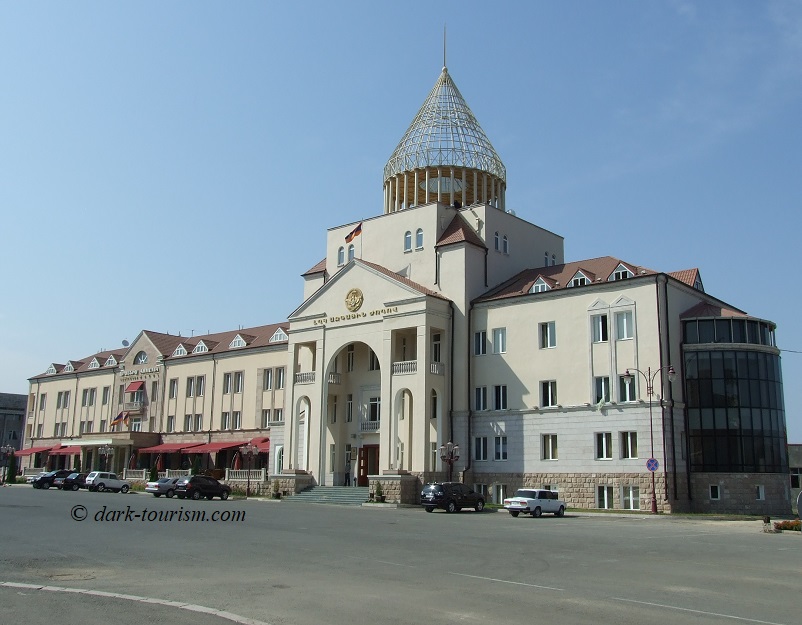
While that building looked pretty well looked after and shiny, another building, the foreign ministry if I remember correctly, was a bit shabbier looking:
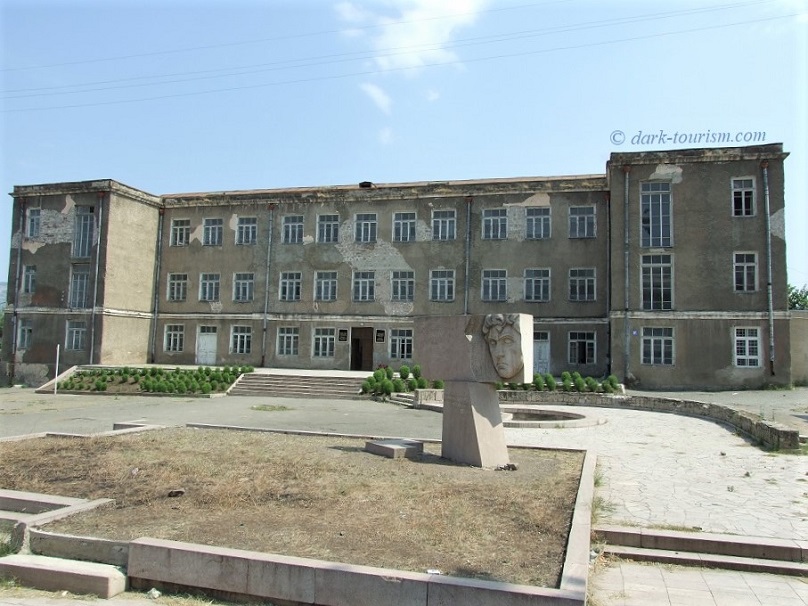
Most of the residential buildings in Stepanakert (other than the few traditional detached houses) are typical Soviet-era blocks such as these:
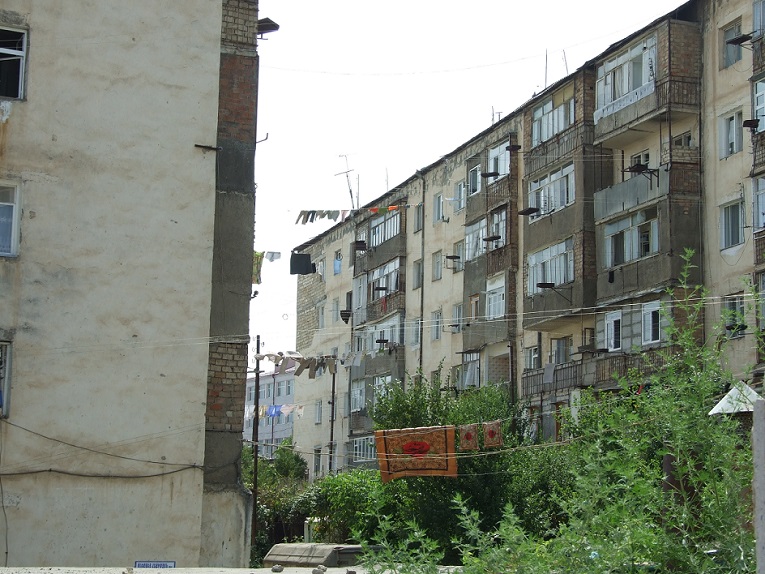
When I visited it the city had three museums of more or less dark-tourism interest. The least dark, but perhaps overall culturally the most important, was the Artsakh State Museum. Here’s a photo of the sign outside the door, which is interestingly in Russian and English only (i.e. not in Armenian!):
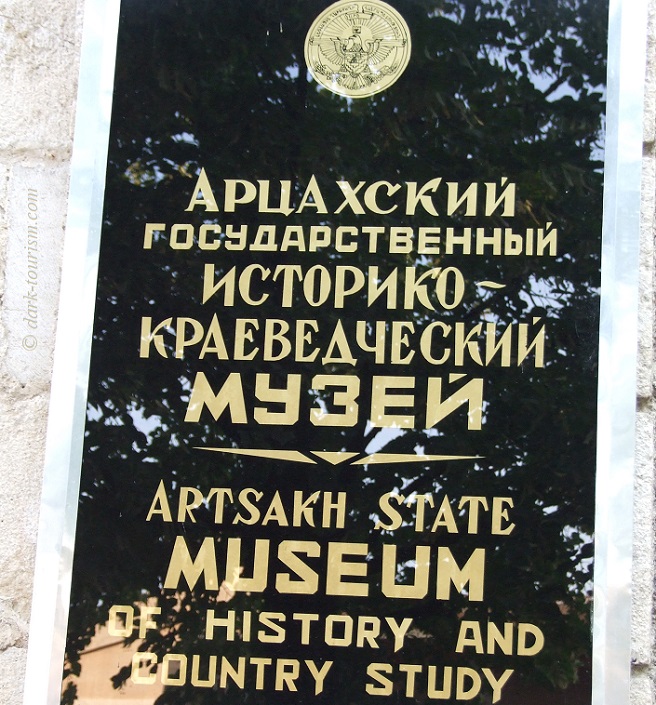
This “State Museum” contains artefacts and info about all historical phases of the region, and only a little bit about the 20th century conflicts.
Another museum I visited in Stepanakert was quite targetedly about the 1990s war. In this case it was about the “Missing Soldiers” of the conflict. This one was trilingual, with Armenian the default. Here’s a photo of the entrance:
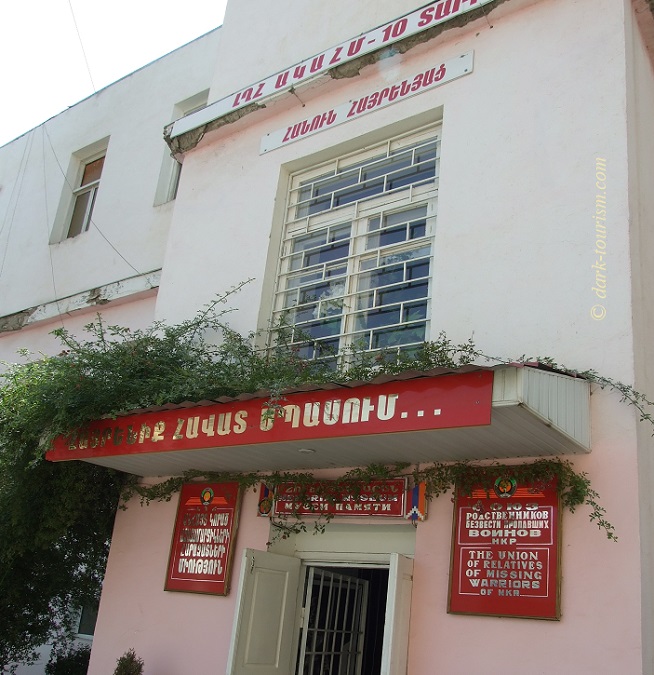
The other, better museum about the 1990s conflict was the Museum of Fallen Soldiers. The two old ladies guiding visitors around were quite endearing. Because the guiding was in Russian, they basically just grabbed my wife, who studied Russian and is a translator and hence speaks the language, to deliver their narrative. Meanwhile I was free to wander around and take photos. Amongst the many artefacts I found, this one has to be the most remarkable:
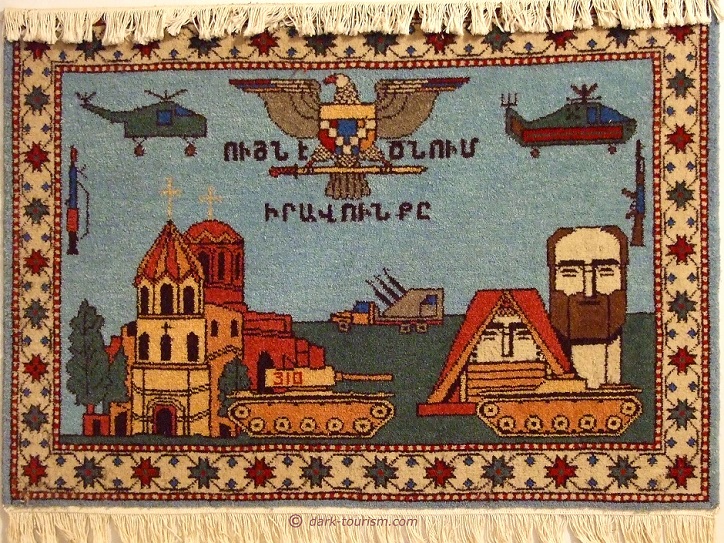
I titled this “Tapestry of War” because it is, literally, a tapestry, but it also works in the figurative sense of the word. It combines traditional images and icons like typical Armenian churches/monasteries, and that Tatik Papik monument again (see above), with more martial depictions of tanks, guns, missiles and helicopters. I found this quite kitschy, but also touching in a strange way.
I guess the fate of these museums will now be sealed too, if they were even still in existence before the latest escalation of the conflict. As I said, the curators/guides at the war-related museums were already quite old when I was there in 2010. Who knows whether they’re still alive and/or who may have taken over looking after the exhibitions. But now that Azerbaijan has asserted control over the region, such clearly nationalistic Artsakh-Armenian institutions are very unlikely to be tolerated any longer. The Artsakh State museum may have the best chances, with its focus on older history, as long as it changes its name, I would imagine.
Outside the capital, the main attraction for dark tourists was Ağdam, once one of the largest ghost towns on Earth. It was not officially allowed for tourists to go there, as it was in the “buffer zone” around Nagorno-Karabakh and the visa issued in Stepanakert would only have been valid for its own territory proper. At times it was, however, possible to sneak in – and many intrepid travellers did. When I was in Artsakh, there had just been a few minor skirmishes on the border and in the buffer zone, so we hired a taxi to drive us only through the edges of Ağdam, but not to the very centre, where soldiers might have been on patrol. Hence I missed out on seeing the fabled abandoned mosque in the centre. However, I did see some of the many, many ruins of houses, such as this one:
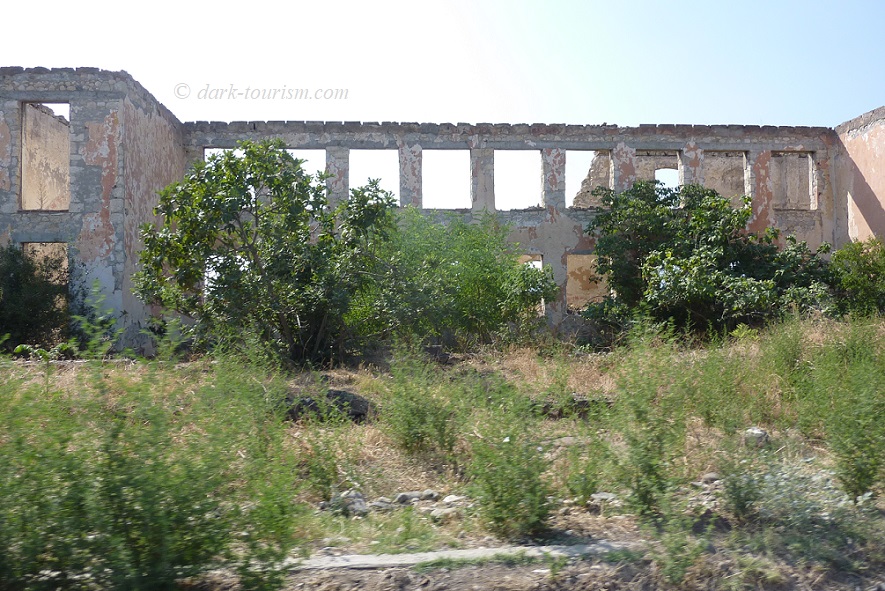
After the 1994 peace deal, when Ağdam fell more or less into Armenian control, it was heavily looted by the Armenians, who basically picked it clean of everything and anything that could in one way or another be used (cables, pipes, whatever). Hence the ghost town’s appearance was at some point likened to that of Hiroshima after the A-bombing. That’s an exaggeration, but may give you an idea. Now Azerbaijan is busy with reconstruction and apparently the first “re-settlers” will soon arrive.
The other town captured by Azerbaijan in 2020 is Shushi (Şuşa in Azeri). Located in the heart of Nagorno-Karabakh, it was also traditionally Armenian, but ethnic clashes in the early 20th century, and in particular the “Shushi Pogrom” of 1920, meant that virtually all Armenians were massacred or expelled from the town, so that for the next seven plus decades, Shushi had a predominantly Azerbaijani population. That changed with the Armenian capture of Shushi in 1992, which was a crucial turning point in the post-Soviet conflict in the region. Now the Azeri-speaking population was driven out and Shushi became Armenian again. The large Armenian cathedral (previously used as a munitions store by the Azerbaijani military) was reconstructed and reconsecrated in 1998, and this was what it looked like when I was there in 2010:
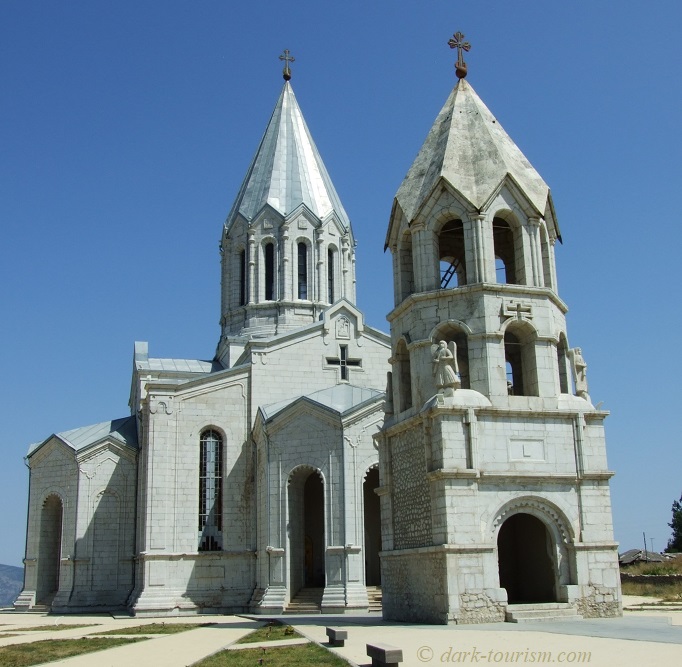
In October 2020, as Azerbaijan tried to “recapture” Shushi (successfully in the end), the cathedral suffered damage from shelling (whether intentional or by “accident” is unclear). The subsequent, and still ongoing “reconstruction” of the edifice by Azerbaijan attracted criticism too, as it allegedly altered the layout of the church. But I don’t know the details
In contrast here’s the mosque in central Shushi, abandoned back in 1992:

(The photo, btw., is not mine but was taken from a photo CD that I obtained from my hotel’s reception when I was in Stepanakert; but I’ve misplaced that CD so cannot look up who the photographer was … it’s probably not of such relevance any more now …)
It can be assumed that refurbishing this mosque will be a priority for Azerbaijan in order to bring it back into operation for the now again Azeri, and hence Muslim, population.
Back in 2010, there were also several hollowed out ruins of whole multi-storey apartment blocks, presumably from Soviet times and lived in by Azerbaijani residents until 1992. Now empty and derelict, they gave the place an eerie atmosphere:

From the ancient fortress on the edge of Shushi you got a view down the hill towards Stepanakert, giving an impression of how short a distance it is to there (and why Shushi has such strategic importance):
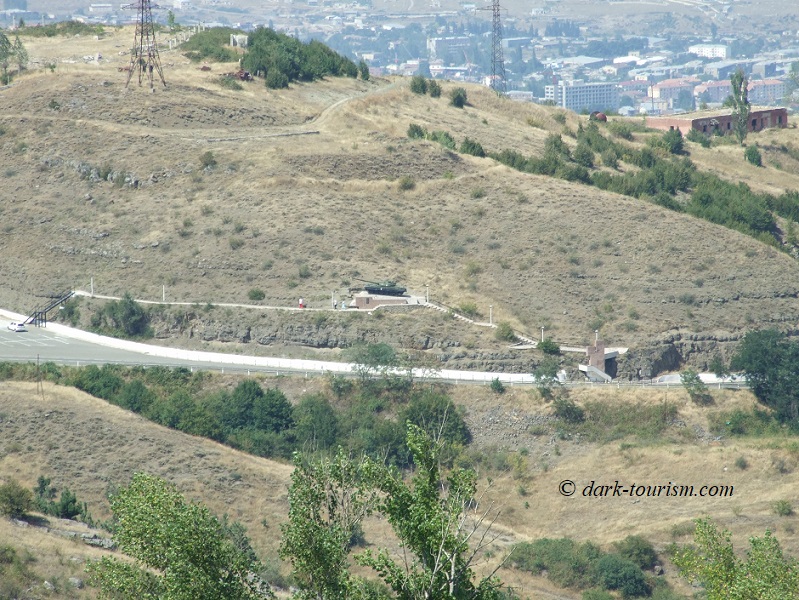
Halfway down the road going up the hillside outside the fortress you can just about make out the tiny shape of a tank in the above photo. Closer up this tank looked like this:
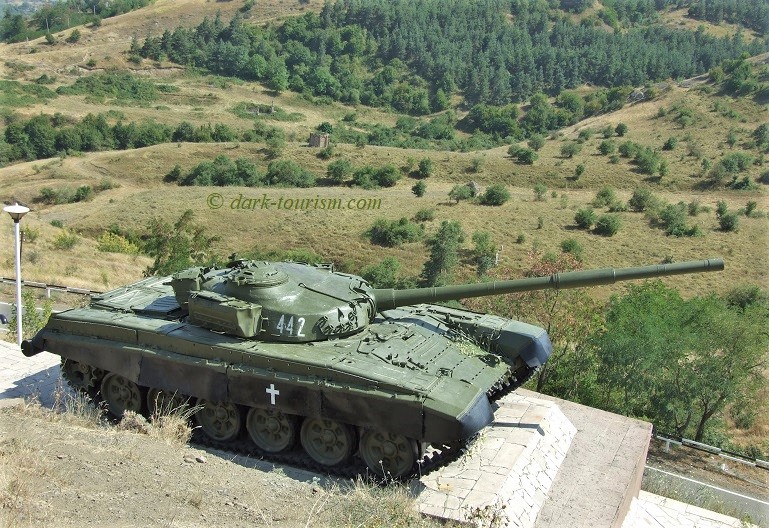
This very Eastern-Bloc-style monument of a tank on a plinth was placed here to commemorate the capture of Shushi by Armenian troops in 1992. Given its symbolism and significance, I’d be very surprised if that was still in place. More likely it was already removed after Azerbaijan “recaptured” Shushi in 2020. But I do not know for sure.
Signs of the 1990s conflict remained visible for many years across the country especially to the east, including some crippled and/or burned-out wrecks of tanks and other military vehicles. Here’s an example:

(Again, this is not a photo of mine but was taken from that same CD as the mosque photo above.)
But apart from such war scars around the country and in Shushi, much of Nagorno-Karabakh felt peaceful when I was there in 2010. Stepanakert by night wasn’t exactly a pulsating party place, but nonetheless there was an indication of “nightlife” in the centre, with two funfairs and numerous open-air cafes, bars and restaurants. Here’s an impression:

Such easy times are now firmly over – at least for the Armenians.
I also did an excursion around the mountains outside the city back in 2010, and especially to an old monastery, seen in the next photo:
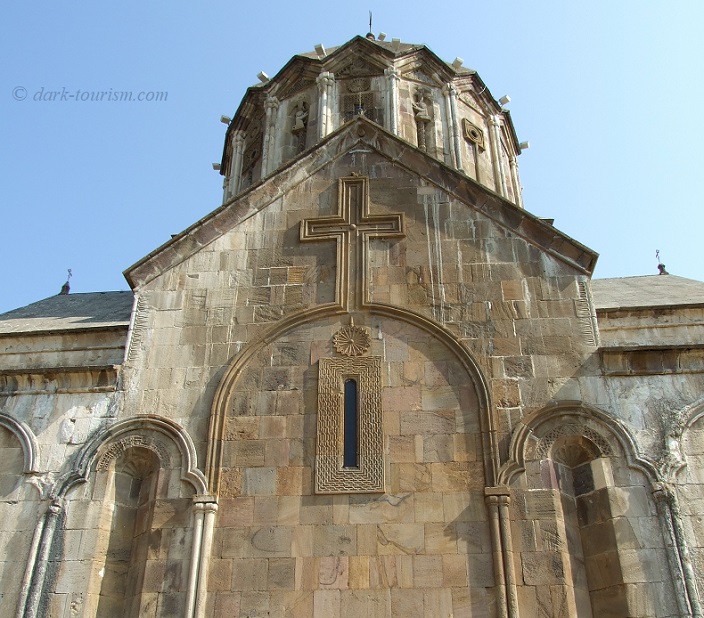
This couldn’t look more typically Armenian in architectural style if it tried. When I was there, it was evidently still in use as well, going by the many lit candles inside and gold-threaded brocades draped over the altar. Whether that would still be the case now seems unlikely.
Finally, here’s a another photo I took in Stepanakert in 2010, in this case one which I can now see as looking unintentionally symbolic:
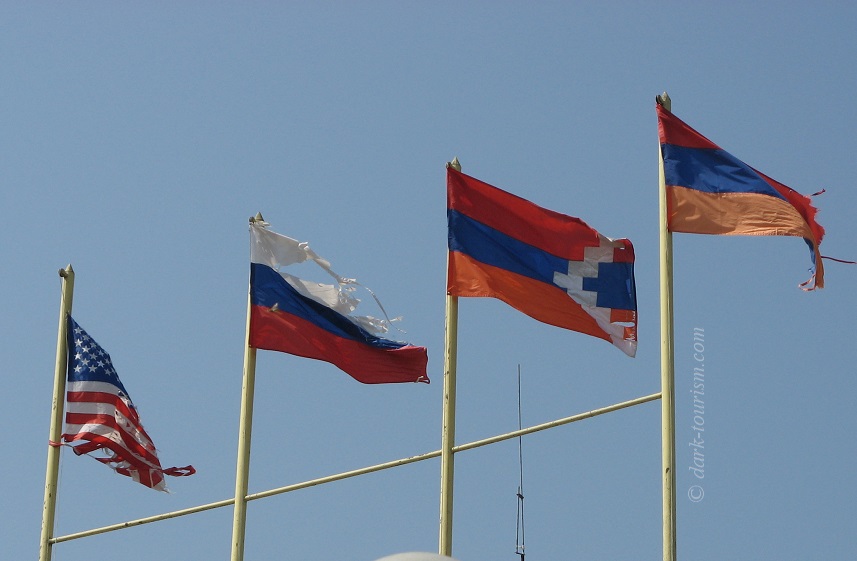
The Arstakh flag is the second one from the right, and ironically the most intact of the set, next to the Armenian flag that its design is derived from. The Armenian flag shows signs of wear and tear … But look at the flags of Russia and the USA to the left! Semi-shredded, almost in tatters. Rarely have I found flags speaking more symbolically …
The situation in Nagorno-Karabakh will need to be monitored further. But one thing seems clear: it is no longer, and most likely never again will be, the exceptional dark-tourism destination it once was. It’s nothing compared to the plight of the civilian inhabitants, but I still find this further blow to dark tourism very sad as well (after my No. 1 DT site in the world, Chernobyl, suffered the same fate last year).
But with this I shall come to a close.

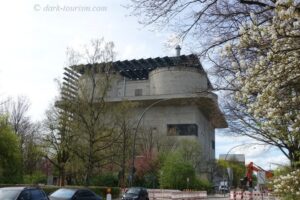
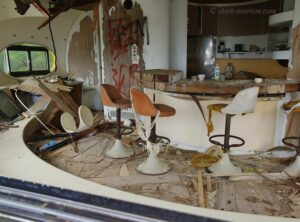
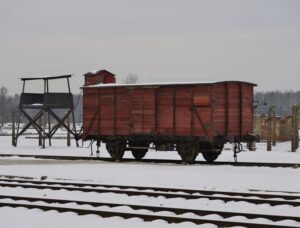
2 Responses
I have never visited Nagorno-Karabakh, but I have visited both Azerbaijan and Armenia in recent years. Both sides provide a one-sided (propaganda) view of the situation. It is sad that this ended in (another) war, many lives are lost, and people have to flee.
However, I feel that this was almost inevitable to happen one day. Azerbaijan basically lost the war in 1988-1994 and many Azeris were killed or had to flee Armenia and Nagorno-Karabakh at that time and people in Azerbaijan are frustrated about that.
From an international law perspective, this area is still considered part of Azerbaijan, and not even Russia or Armenia had officially recognized Republic of Artsakh. I can understand that Azerbaijan wanted the breakaway region of Nagorno-Karabakh back under control. It is very sad to see however that it seems that no peaceful solution could be found and that the different ethnic groups and religions cannot live peacefully together in one area.
Naturally there’s propaganda on both sides, but you can’t put Armenia on a par with Azerbaijan. The former is a functioning democracy, the other a dynastic dictatorship with an abysmal record in terms of press freedom, human rights, etc.! I’m aware of the de jure status Nagorno-Karabakh had, but the de facto status of the territory was widely accepted for three decades. Btw. Azerbaijan didn’t so much “lose” the war in 1994, Heydar Aliyev (the current dictator’s father and predecessor) engineered the peace deal back then to prevent civil war and societal collapse. True, Azeris were displaced from the buffer zone, in particular Agdam, and also Shushi (while the Azeris had previously massacred and driven out Armenians from there – there’s a lot of tit for tat involved here …). I could have half understood that Azerbaijan wanted Agdam back (though it’s a great loss for DT), but the heartland of Artsakh was never Azeri, it’s the Artsakh Armenians’ homeland. It only fell within Azerbaijan’s territory due to random border re-drawings in the Stalin era. But it was never Azeri. So you can’t really say they wanted it “back”. What they now want with it remains a mystery – leave it empty? Settle Azeris there? We’ll see. There’s also the fear that this may not be the end. Armenia is worried that the land grab could go further (e.g. by enforcing a land bridge to Nakhchivan). And let’s also not forget the involvement of Turkey – another quasi-dictatorship and traditionally the arch-enemy of Armenia (which culminated in the genocide of Armenians by the Ottoman empire in 1915 – not forgotten by Armenians but denied by modern Turkey). There’s a lot of imbalance here.